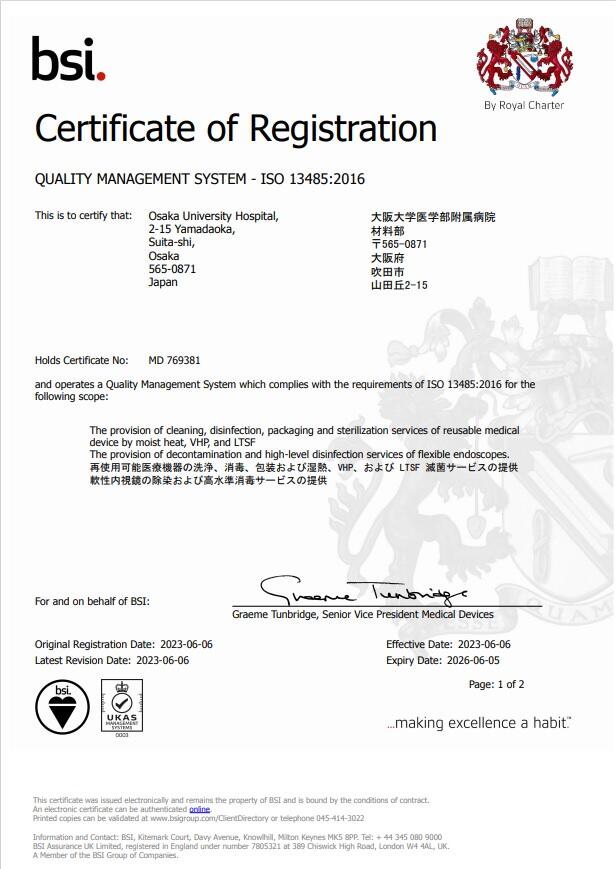- HOME
- Guide for Visitors
- Sterile Supply
Sterile Supply
Safe and Secure Medical Equipment Supply Service
The University of Osaka Hospital's Central Sterile Supply Department was established on February 20, 1971 in order to provide efficient and reliable sterilization, by centralizing the cleaning and sterilization of reusable medical devices and procurement of single-use medical devices, which had previously been done independently in each section and department. With the relocation to the Suita district in September 1993, its scale and functions were greatly expanded. Cleaning and disinfection of flexible endoscopes were centralized in April 2008, and initial washing by each department was abolished in April 2009 as we proceed with the centralization process. Duties of Sterile Supply also include cleaning, sterilization and maintenance of complex surgical equipment used for surgical robots and delicate equipment used for dental treatment. The staff who manage these operations are qualified first-class sterilization technicians, of which there are only about 400 nationwide. In this way, Sterile Supply guarantees the quality of medical equipment that is reused in the hospital by its highly educated and professionally qualified staff, striving for safe and reliable medical equipment supply service.
Staff
Sterile Supply's staff consists of the director (professor), a deputy director (first-class sterilization technician), 1 technical staff (first-class sterilization technician), and 1 special technical staff (first-class sterilization technician).
Cleaning, disinfection, and sterilization of reusable medical devices (RMDs) are performed by 59 outsourced employees.
The overall logistics of single-use devices (SUDs) from ordering to inventory is handled by 17 outsourced employees (SPD: Supply Processing and Distribution).
Facility Certification

Some medical devices used in medical procedures such as surgery and treatment can only be used once, while others can be cleaned, sterilized and used multiple times. For the latter, it is essential to ensure quality cleaning and sterilization.
The University of Osaka Hospital's Central Sterile Supply Department has obtained certification for cleaning and sterilization in accordance with ISO13485:2016, the international standard for quality management systems. This is the first time in Japan that a hospital supply department has acquired this certification. In this way, the Central Sterile Supply Department strives each day to ensure that patients can receive treatment with peace of mind.
Operations
Washing
Contaminants such as blood, body fluids and minute tissues and micro-organisms adhere to reusable medical devices used in wards, outpatient clinics and surgery. To remove them, washing is performed by combining the chemical action of detergent and the physical effects of water flow, ultrasound, and brushing.
- Washer-Disinfector (WD)
Contaminants are removed by spraying with a pressurized water stream, and disinfection is done with hot water. - Vacuum boiling washer
The cleaning fluid is boiled and bumped by the pressure change to remove the dirt on the immersed items for cleaning. It can be used to clean items that are difficult to reach by spraying. - Ultrasonic washer
Removes hard-to-remove contaminants and invisible fine contaminants with ultrasonic waves.
Sterilization
Steam sterilization (autoclave), low temperature steam formaldehyde (LTSF) sterilization, and hydrogen peroxide gas plasma sterilization are used.
- Steam sterilization (autoclave)
This is a method of killing micro-organisms by denaturing their proteins using the thermal energy of saturated steam. It is used to sterilize medical equipment that can withstand high temperature and high pressure, such as steel articles and linen. It is widely used because it is safe and low cost. - Low temperature steam formaldehyde (LTSF) sterilization
A mixture of formaldehyde and cold steam kills micro-organisms. It is used to sterilize medical equipment such as flexible endoscopes and plastics that cannot withstand high temperature and high pressure. The scope of application is almost the same as ethylene oxide gas (EOG) sterilization. - Hydrogen peroxide gas plasma sterilization
Free radicals generated by applying high frequency energy to hydrogen peroxide steam kill micro-organisms. It is used to sterilize medical equipment that cannot withstand high temperature and high pressure. Although sterilization time is short, the cost is relatively high compared to the others. In addition, it cannot be used to sterilize paper, gauze, linen (textiles), etc.
Washing and disinfection of flexible endoscopes
In addition to the gastrointestinal and bronchial endoscopes used in diagnosis, treatment and tests at the Endoscopy Center, this center also cleans and disinfects flexible endoscopes used for outpatients of Otorhinolaryngology, Urology and Gynecology, processing about 25,000 a year.
- Automated endoscope reprocessors (AER)
All pipelines are cleaned with a pressurized stream of water and disinfected with a high-level disinfectant.
Overview of Facilities
Washers
| Washer-disinfector (WD) | 6 |
|---|---|
| Vacuum boiling washer (RQ/RN) | 3 |
| Tabletop ultrasonic washer | 1 |
| Automated endoscope reprocessor (AER) | 13 |
| Thermostatic immersion bath | 7 |
| Thermostatic bath with ultrasound | 3 |
| Thermostatic bath with water supply function | 5 |
Sterilizers
| Steam sterilizer (584 L) | 2 |
|---|---|
| Steam sterilizer (858 L) | 3 |
| Formaldehyde/steam hybrid sterilizer (584 L) | 1 |
| Hydrogen peroxide gas plasma sterilizer (100NX/NX/100S) | 4 |
Disposables room
In pursuit of economic efficiency and rational management, the purchase, supply, and inventory management of single-use medical devices have been centralized under outsourced management. A logistics management system using RFID (radio frequency identification) was introduced in 2021 to improve operational efficiency such as management of expiration dates and unmoving stocks.
- HOME
- Guide for Visitors
- Sterile Supply
Information for Outpatients
Consultation times
| First visit | 8:30 am to 11:00 am |
|---|---|
| Follow-up visit | 8:30 am to 11:30 am |
| Follow-up visit with appointment |
8:30 am to 3:00 pm |
※First-time visitors to The University of Osaka Hospital must have a referral from a physician.
Outpatient consultation days
Monday to Friday
Non-consultation days
Saturdays, Sundays, Holidays New Year’s Holidays: Dec. 29 to Jan. 3
